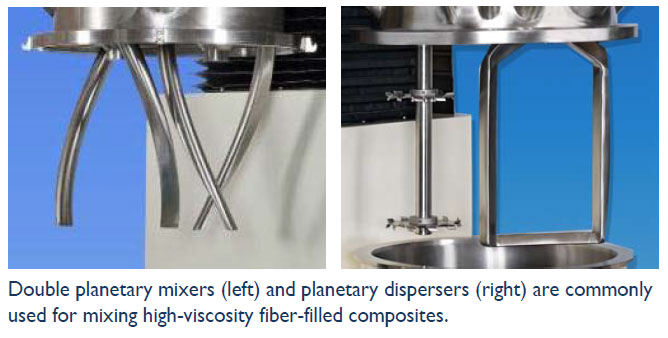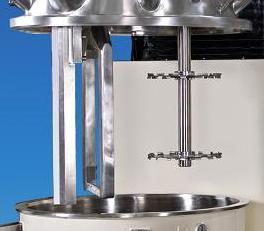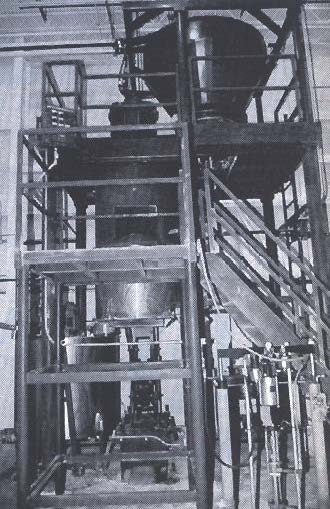Tech Report
Effectively disperse fibers into your viscous mix.

Technology Brief
Many fiber-filled composites are high viscosity formulations that require efficient dispersion in a planetary mixer configuration where a number of blade designs and combinations are available. Fiber characteristics and composite rheology are the main factors evaluated in the mixer selection process.
Fiber-filled composites
The addition of fibers gives rise to novel properties in many materials. For example, the mechanical properties of glass fiber-reinforced polymers are better than those of unreinforced polymers and in many applications they are sufficiently high enough to compete with metals on a unit weight basis. High-performance fibers, such as carbon or polyaramide, offer exceptional strength and stiffness in advanced composites. A ceramic matrix, brittle and sensitive to fracture induced by thermal stresses, may be reinforced with ceramic fibers to increase its resistance to crack propagation. Other composites are designed with a view to enhance the chemical resistance, conductivity or adhesion of traditional materials.
All these characteristics have contributed to the application of fiber-filled composites to many fields, from automotive and aerospace components, to medical devices, electronics and recreation products.Considerations for mixer selection
In addition to product viscosity, the characteristics of the fiber material (length, shape/form, rigidity, percentage, etc.) are important considerations in mixer selection. Certain fibers readily disperse into the bulk phase and do not require intense agitation. Smaller fibers, such as polymer microfibers, are generally more difficult to disperse completely and require high speed mixing. Detangling the bundles of individual strands increases fiber surface area in contact with the matrix, typically resulting in improved composite strength.
Double planetary mixers
Double planetary mixers are well proven equipment for the processing of fiber-filled composites. They move material by rotating two identical blades on their own axes as they orbit on a common axis. In 36 revolutions, the blades have contacted virtually every point of the batch.
Most traditional double planetary mixers utilized blades with a rectangular open paddle design. Others featured finger blades for handling delicate fibers. These stirrers are ideal for processing viscous products up to 3 million cP. Today, helical planetary blades are available which extend the mixer`s viscosity range to up to 8 million cP. This is a welcome development for many industries that routinely produce high-viscosity formulations, including highly-filled composites. The helical blade’s unique sleek contour also makes it possible to efficiently blend fibers that would otherwise wrap around the shafts of conventional agitators.
Hybrid planetary mixers
With viscous composites that require high speed mixing to achieve the desired level of fiber dispersion, a hybrid planetary mixer is commonly used. This design consists of a planetary stirrer and a high speed disperser blade that revolve on their own axes while orbiting the vessel on a common axis.
Shear levels and flow patterns are easily fine-tuned because the agitators are individually-controlled. Fibers and other solid components are quickly incorporated into the viscous bulk material and stubborn agglomerates are dispersed regardless of product flow characteristics.
Ross Planetary Mixers: Sample Configurations

Double Planetary Mixer with Rectangular Stirrers

Double Planetary Mixer with High Viscosity "HV" Blades

PowerMix Planetary Disperser with Rectangular Stirrer, Dual-Blade High Speed Disperser and Sidewall Scraper Arm

Planetary Dual Disperser with Two Rectangular Stirrers and Two Disperser Shafts
Sample Application: Glass Fiber-Reinforced Polyester

At Therma-Tru`s Butler, Indiana facility, a 200-gallon Ross Double Planetary Mixer is being used to produce glass fiber-reinforced sheet molding compounds that make up the company`s main product: heavy-duty, energy-efficient, low-maintenance doors.
The mixer is integrated with automated controls and mass flowmeters to ensure the correct proportion of the A and B components. The A mix carries catalyst, filler and polyester resin. Part B is essentially a highly saturated polyester resin with pigment and chemical thickeners.
A stainless steel vessel is raised to meet the mixer blades during operation and lowered during routine clean-up and maintenance. This allows complete access to the blades without disturbing the mixer cover which is piped to raw material feed lines.